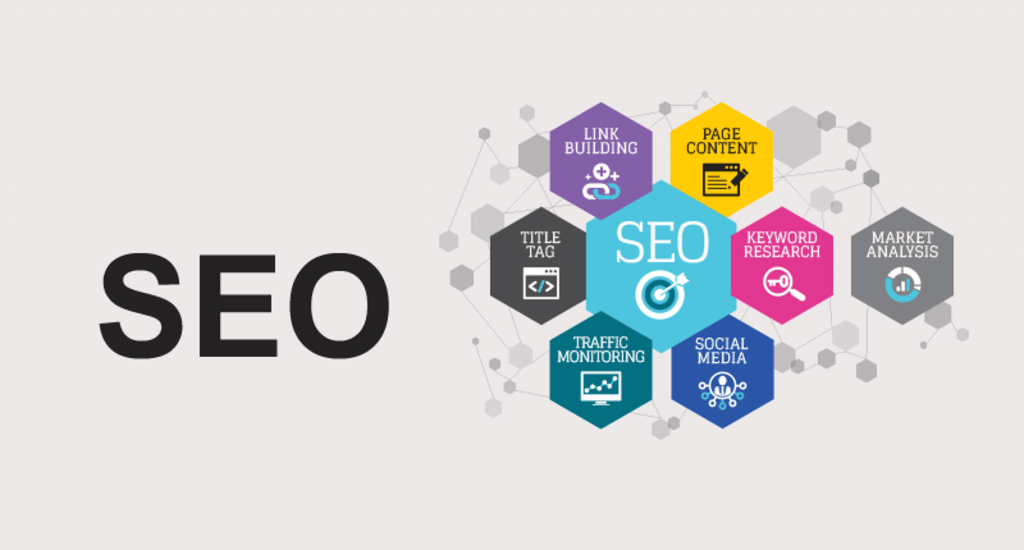What is SEO? Definition, how it works and complete guide to search engine optimization (2023)
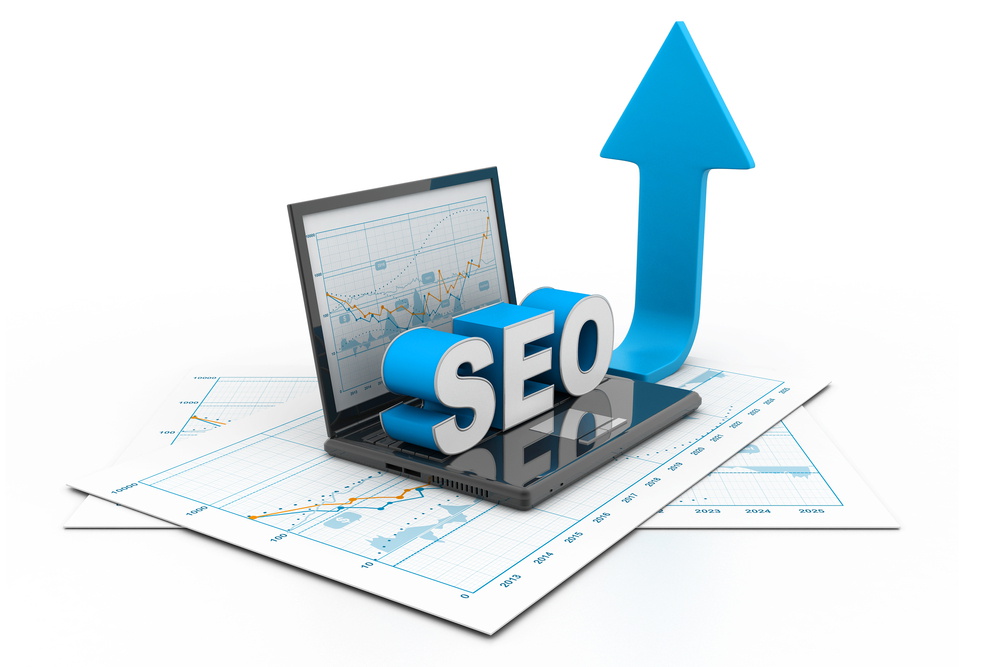
What is SEO? SEO is the abbreviation of Search Engine Optimization (search engine optimization). It is the set of techniques and strategies focused on optimizing organic positioning in Internet search engines. Some examples are Google, Bing, Baidu, Yahoo!, Yandex, DuckDuckGo or YouTube.
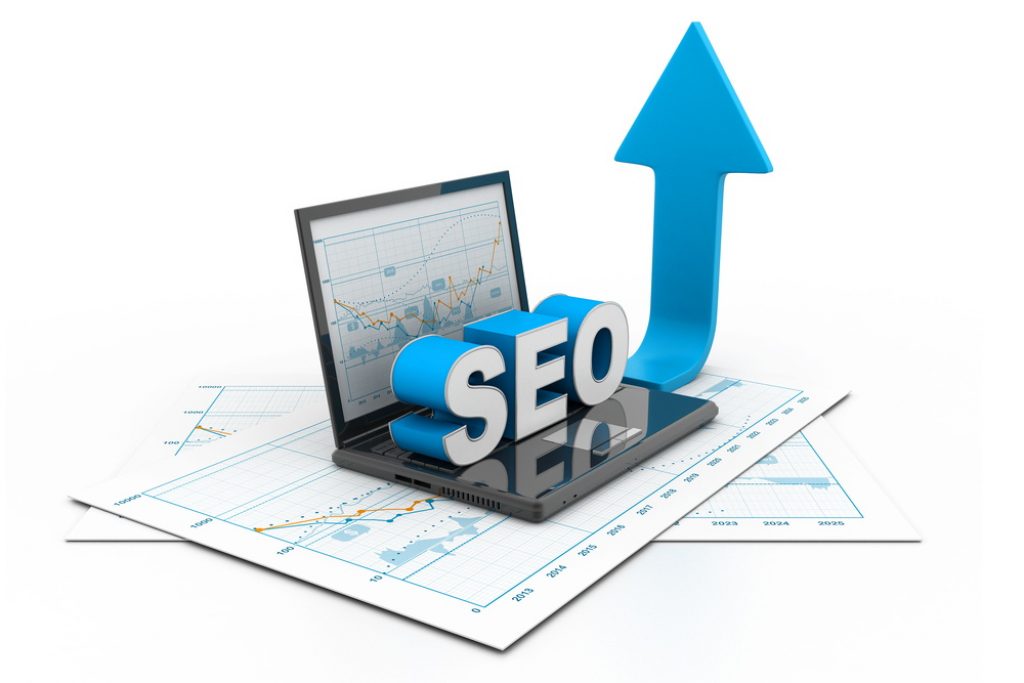
Having a web page for your brand or company is the basis of any digital presence, but the effort to create it is useless if you don’t make sure that your audience finds it. Therefore, it is essential to make Google work in your favor. We are going to see what SEO is, why it is so important and how search engines work.
INDEX
- What is SEO or Search Engine Optimization?
- What are the origins of SEO?
- Why is SEO or web positioning important?
- Understanding SEO: search engines
- The 10 keys to SEO positioning
- Main SEO strategies
- Blackhat vs. Whitehat
- The importance of mobile first indexing and best practices
- SEO analysis: the best tools
- SEM and SEO: what are the differences
- Google and local SEO
- Link building strategy and guest posting
- How to choose your SEO agency?
- SEO learning resources
What is SEO or Search Engine Optimization?
SEO stands for Search Engine Optimization (optimization for search engines). It is the process of improving the visibility of a website in the organic results of any search engine.
It is very important to be clear that SEO refers to organic results, that is, not paid. The complementary option (paying a cost per click to occupy the first places for a certain search) is known as SEM or Search Engine Marketing. To put a metaphor, SEO is similar to looking for a good free parking lot next to the place where you have to go, while SEM would be the equivalent of paying for a parking lot.
As with almost all online marketing disciplines, SEO has come a long way over the years . In its origins, web positioning techniques were very primitive and were based a lot on repeating some specific keywords, while now the user experience is much more important.
The concepts and techniques that you should take into account within the world of SEO are:
- SEO consultant . The professionals responsible for advising you, helping you and developing your positioning strategy in search engines.
- Organic or natural positioning . It is the content strategy based on seeking the first organic positions in search engines.
- SEO analysis . The part focused on data analysis of SEO positioning, to improve and optimize content in real time.
- SEO positioning or web positioning . They are other synonyms for organic or natural positioning. There are many types of techniques to achieve this goal.
- Search engine positioning . The natural positioning in search engines. Each search is called a SERP.
- Mobile First Indexing . Google uses the information found on the mobile version of a website to compile search results.
- SEOMarketing . All marketing techniques focused on improving organic search engine positioning.
- SEO Strategy . Planning the techniques that will be developed to improve web positioning.
- Guest blogging . Guest authors on a blog. It gives value and relevance if the editors are important people in the sector.
- Link building . Strategy based on the search for inbound links to our website.
- Blackhat SEO . SEO techniques penalized by search engines.
- Whitehat SEO . SEO techniques endorsed by search engines, ethical and that help develop a healthy and lasting SEO over time.
- SEO Agency . Companies specialized in positioning in search engines.
- SEO and SEM . Differences between two concepts related to appearing in search engines. Although SEO is organic positioning and SEM is the payment strategy to appear with ads.
- SEO on Google . SEO strategy focused on “liking” the most used search engine worldwide.
- Local SEO . Positioning strategy focused on appearing in queries made by users locally (close to our location).
- SEO expert . Professional who has focused his career and experience on developing SEO strategies for clients.
- Pillar pages and topic clusters . How to create pillar content to rank better for a given keyword and then create a cluster of content around it to improve the rank of the pillar page.
- SEO optimization . Techniques that seek to improve the positioning of a keyword or content.
On the other hand, broadly speaking, there are two basic factors that define the positioning of a page: relevance and authority .
The relevance in web positioning
The relevance of a web page can be defined as its correspondence with a certain search , that is, how well it responds to the question or request made by the user. The objective of Google and other search engines is to give the best possible service to users by offering them pages that are relevant to them.
To control this factor, we use SEO on site techniques , dedicated to improving our own website. Their goal is to make search engines understand what your content is and how it relates to user searches. To do this, techniques such as keyword and URL optimization, loading time reduction, user experience improvement, etc. are used.
Authority and SEO
Secondly, we have authority, which we can define as the popularity of a website . The more “votes” a website receives through links, the better it will be considered by search engines.
To improve the authority of a website , off-site SEO techniques are used , which focus on factors external to the website itself. What is sought is to improve the parameters that define the popularity of a website for search engines: links to the website, presence in social networks, mentions in the media, how many users click on our website when it appears in their search results. search etc
Finally, it is worth mentioning that we can also distinguish between White Hat SEO, which is one that is based on the practices recommended by the search engines themselves, and Black Hat SEO, which seeks to take advantage of the “gaps” to manipulate the results quickly. Although it can sometimes get results in the short term, in the long term the Black Hat is never worth it.
What are the origins of SEO?
Although nowadays it seems absolutely essential to us, the truth is that Google did not appear until the year 96 and even today there are countries in the world where it is not particularly popular. The origins of this type of tools, called search engines, date back to the early 90s, when the rise of web pages began.
Almost all web pages have the same goal in common: attract quality traffic. Search engines are one of the most effective ways to bring in visitors potentially interested in the web topic in question. Webmasters realized this and began to compete with each other to rank higher in search engines . SEO was born.
Why is SEO positioning important?
Understanding what SEO is and putting a good strategy into practice is essential for the future of your brand. Do you think we exaggerate? Take a look at these reasons:
- Multiply your visibility. Imagine that you manage to position your website for a term with 500,000 monthly searches. If the first result that appears in the search engines gets 20% of the clicks, you would be getting 100,000 organic monthly visits, that is, they do not entail any additional cost.
- Improve your website . Well done, web positioning techniques not only improve your page for search engines, but also for the users themselves. And improving the user experience means improving your results.
- It is a long term investment . Optimizing your website has some initial costs, but if you manage to rank among the top positions, you will have a fantastic source of quality traffic at no cost. Continuing with the previous example, imagine that 1 in 100 users who visit your website end up making an online purchase and that the customer’s lifetime value is 100 euros. In that case, you would be generating 100,000 euros per month in income. And of course, if you position for several keywords or launch yourself into international SEO, the benefits multiply.
- Monetize your website. If you have made a valuable investment in money, time and resources to build a website that represents your brand, the logical thing to do is to get as many users as possible to visit it to take advantage of that investment.
- Increase your impact on social media . Web positioning creates synergies with social media, since the links that are shared on the networks make use of the titles and descriptions that you will have optimized as part of your positioning strategy.
- Build trust and credibility . As I have already explained, authority and relevance are the two key factors of SEO. Therefore, when your website appears among the first search results, users know that it is a site that contains the information they are looking for and that it has been approved by many users. In short, it gives them the confidence they need to launch themselves to convert.
- It can be measured and optimized. It is possible to evaluate the results of all the techniques and factors that intervene in your SEO, to see which ones are giving the best results and correct the course if necessary.
Understanding SEO: search engines
To fully understand how SEO works, we need to see what happens when Google’s “spiders” roam the web. Its operation can be summarized in two steps: crawling and indexing.
To understand how tracking works, think about the transportation system of a big city. Every web page or document (such as a PDF or image) is one stop. In order to record the content of each stop, the search engine needs to crawl the entire city, and for this it uses the best available path: links.
The link structure of the web is what connects the pages to each other, which is why they are so important in optimization. Search engine bots use sitemap and previous crawl addresses to begin their search and navigate from link to link. In this way, they are reaching the documents stored on the web.
Not all websites are crawled to the same depth or for the same amount of time. Spiders are especially attracted to new content , whether a site has been built from scratch or an existing one has been updated. The charging time is also decisive.
The second step is indexing. Once these documents are found, they deal with deciphering their code and saving some “pieces” of it so that they can be retrieved when a user does a search. As you can imagine, these “pieces” together represent a huge volume of information. For this reason, companies like Google have massive data centers where they store this information, so that it is easily retrievable.
All this information on the web pages and documents available on the network is ordered in a series of indexes based on their content, their authority and their relevance. The criteria have evolved over time and are increasingly complex; In addition to keywords, factors such as the publication date, whether they contain multimedia elements, the quality of the content and many others are taken into account.
And with these two steps, everything is ready for the user to search. At this point, an algorithm is launched that searches the indices and sorts the results based on hundreds of ranking factors, all in a matter of milliseconds. It’s not magic, it’s SEO.
The 10 keys to SEO positioning
The organic positioning of a website is influenced by a multitude of factors, which have also evolved over time and the advances of search engines. We are going to see the 10 great keys of SEO on-page and SEO off-page .
1) SEO-on page: work on the keyword strategy
Any natural positioning strategy should start from a good keyword analysis, which takes into account aspects such as search volume, the level of competition, seasonality and the relevance of the term for the brand.
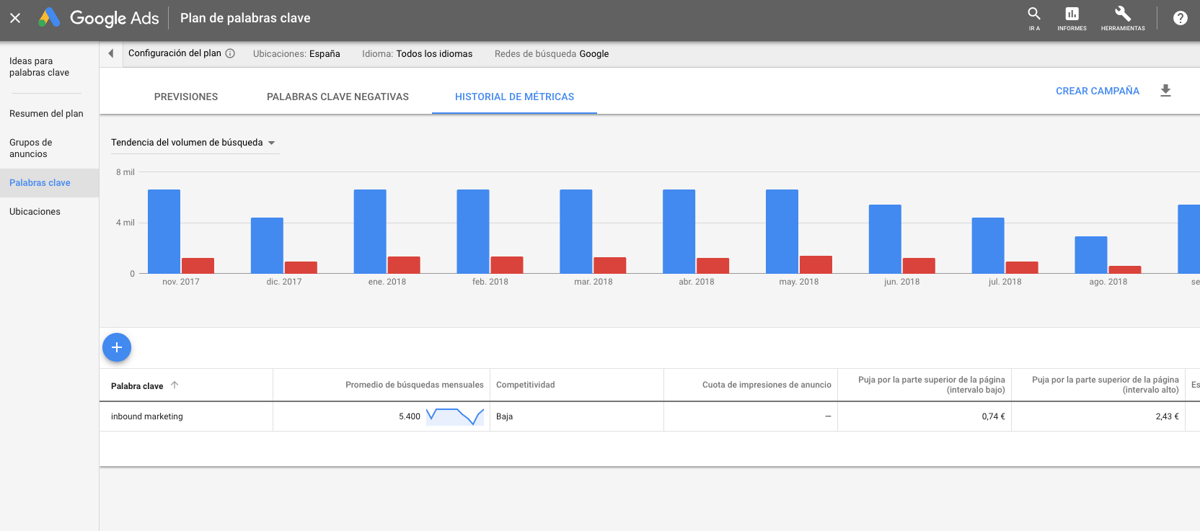
2) SEO-on page: optimize URLs
URLs should be short, easy to read and index by search engines. Try to make them as simple as possible and contain the main keyword of the page they refer to. This last point is an essential part of web positioning . If the keyword is not included, Google will not correctly index the content.
3) SEO on-page: structure the pages with headers
Heading tags (H1, H2, H3…) are essential to organize the information within each text, both for search engines and for users.
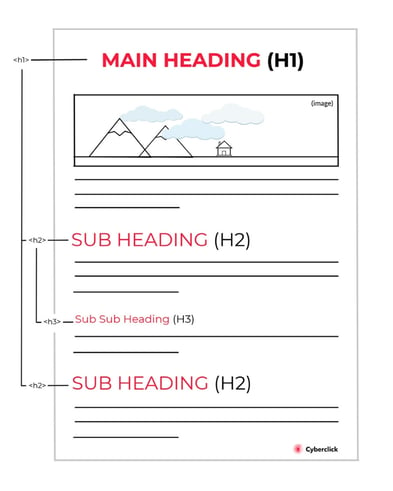
4) SEO on-page: take care of loading times
Google penalizes pages with very slow loading times, which also generate a high bounce rate and worsen the user experience. Therefore, it is convenient to carry out a complete technical audit to optimize all the factors that influence the loading speed. To facilitate this job of SEO positioning, one of the most used tools to evaluate the loading speed of a page is PageSpeed Insights.
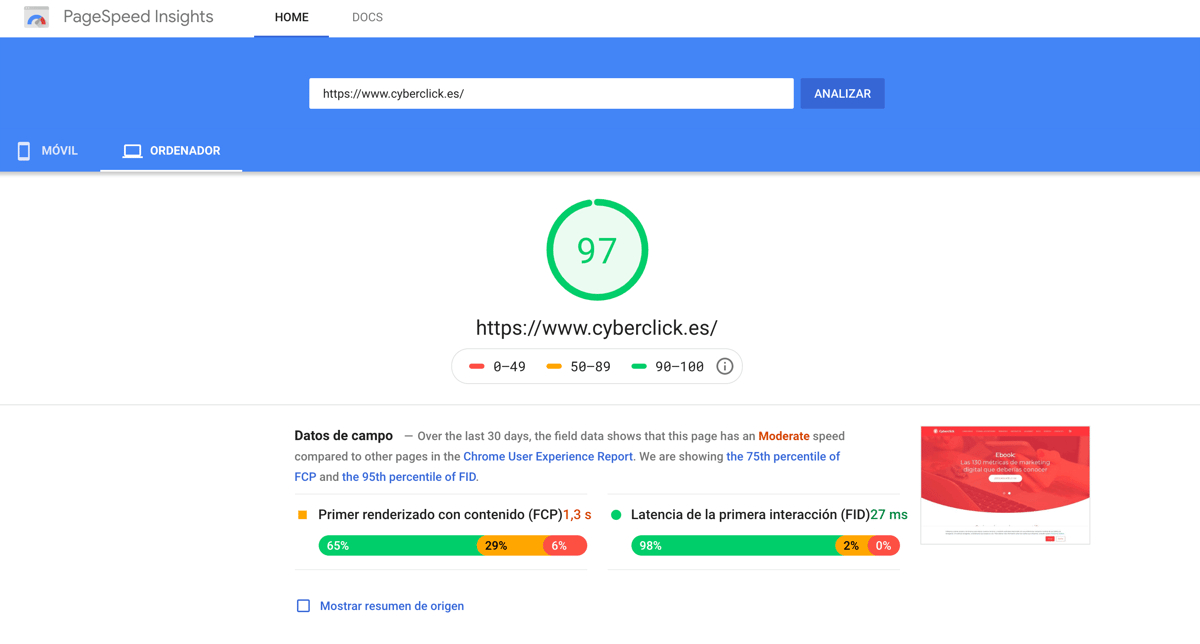
5) SEO on-page: create quality content
In the end, both Google and users value well-structured, easy-to-read content that provides in-depth information. Watch this video to learn how you can develop a successful content strategy that helps you rank naturally in search engines and in the TOP 1 position .
6) SEO off-page: get quality inbound links
Link building is a key factor in SEO positioning, but not everything goes. Always bet on natural techniques to generate quality links.
7) SEO off-page: do video marketing
Quality videos generate many links to your website, and if you post them on YouTube, they will also show up in Google search results.
8) SEO off-page: do guest blogging
Guest blogging is a very effective technique both to position yourself as an SEO expert in a sector and to generate inbound links to your website.
9) SEO off-page: create infographics and other graphic elements
The richer your content is, the easier it will be for you to generate inbound links organically. Infographics are one of the most popular formats, especially if they are based on your own studies .
10) SEO off-page: commitment to networking
In the end, what works best to improve the reputation of your website is to interact with other people in your sector and look for opportunities to collaborate with each other. You will all win!
Main SEO strategies
As the positioning evolves, so do the SEO strategies that are applied. These are the main trends in SEO strategies that you should take into account for your website:
- Voice searches . It is estimated that by 2020, 50% of searches will be done through voice, with technologies such as smart speakers or the Google assistant. This implies an important change in the way positioning is approached, since voice searches tend to be longer, more long-tailed and expressed in a more natural way.
- The intentionality . Artificial intelligence is increasingly playing a more prominent role in positioning. For this reason, instead of searching for keywords blindly, search engines are able to detect the intention of a user even if they express their search in different ways. Therefore, the focus should always be on the utility for the user and quality content.
- Google position zero . More and more, Google searches incorporate a result in “position zero”, that is, it shows part of the content of a page as a direct answer to the user’s question. In order to appear here, it is important to include rich data on your website.
- Mobile prioritization . It is a fact that for years Google decides the ranking of the web based on its mobile version, not the computer version. Therefore, there is no excuse for not having a perfectly optimized mobile website, either through a responsive design or AMP (Accelerated Mobile Pages).
- Brand awareness as an SEO factor . As Google’s algorithms get smarter, it looks like factors like unlinked brand mentions could start to play a role. In the end, brand awareness and positioning are two elements that benefit each other, so both must work well.
Blackhat SEO vs. Whitehat SEO
In the world of SEO we can distinguish different “schools”, since there are many possible techniques to improve the positioning of a website. But the most important distinction is that of blackhat SEO versus whitehat SEO .
blackhat seo
We call blackhat SEO the use of unethical positioning techniques or even explicitly prohibited by search engines. In the short term it is possible to improve the ranking of a website with this type of practice, but in the long run it is never worth it, since these practices end up being detected and severely penalized.
Among the most common blackhat SEO techniques we have:
- Cloacking : creating a web directed to search engines (but unreadable for humans) and “cloaking” it with another web directed to users but that is not crawlable. Google’s rules include that the content directed to search engines and users must always be the same.
- Keyword stuffing : repeating a keyword over and over again so that Google positions us for it, negatively affecting the quality of the content and the user experience.
- Hidden text : another practice that violates the rule of showing the same content to search engines and users, in this case hiding texts with the same color as the background or small font sizes.
- Spinning : automatic creation of content optimized for search engines but of low quality.
- Link Trading – Inbound links should always be sourced organically.
whitehat seo
On the other side of the coin we have whitehat SEO , that is, the one that uses only ethical positioning techniques and that have the blessing of search engines. We must always bet on whitehat SEO and keep in mind that it will provide us with solid and permanent results in the medium/long term.
Whitehat SEO techniques are the on-page and off-page SEO practices that we discussed above: optimizing URL structure and load times, adding headers, incorporating multimedia elements, guest posting, etc.
The importance of mobile first indexing and best practices
Today, traffic from mobile devices exceeds that from computers. And since Google is well aware of this, it has incorporated mobile first indexing into its algorithm.
The mobile first indexing consists of the fact that the Google algorithm first takes into account the mobile version of a website to determine its positioning. For webmasters, this means that the mobile web should be considered the main version and therefore should be perfectly optimized. To do this, it is recommended either to create a single version of the web with responsive design, or to use the Google Accelerated Mobile Pages tool, which is used to design websites focused on optimization and loading speed.
In addition, it is always a good idea to put these Google recommendations on mobile first indexing into practice:
- Make sure that the Google crawler can access and render all the resources and content of your website. To do this, use the same robots meta tags on both mobile and desktop, don’t let important content lazy load (for example, when a user clicks somewhere on the page), and let Google crawl all your resources.
- Check that your mobile website includes the same content as your desktop site and uses the same headers on both.
- Check your structured data (rich snippets) : make sure the mobile site includes the same as the desktop version, check that the structured data URLs of the mobile site are for mobile and if you use the Data Marker, train it with the site Web.
- Use the same metadata on both versions of the site.
- It follows the Better Ads standard for displaying ads on mobile devices.
- Make sure your website’s visual content (images and videos) follows best practices , such as providing high-quality images, using supported formats, and placing videos in a place that mobile users can easily find.
SEO analysis: the best tools
To facilitate the task of SEO positioning and analysis , it is always a good idea to rely on a tool that can simplify our work. To get started, write down 5 of our favorites:
IS RANKING
An advanced all-in-one tool that is useful for both agencies and marketers. It has powerful SEO tools ranging from keyword and competitor rankings to backlink analysis, technical SEO audit, and content optimization. In addition, it offers a package for agencies with white label customization, automatic reports and the option to add additional users with specific access permissions. Actually, everything you need in a single SEO platform.
Google Keyword Planner
The classic of the classics. Just by entering a keyword or website, you’ll be able to see tons of related keyword suggestions and data like search volume, competition, and cost per click. Of course, if you do not have an active Google Ads account, some data is restricted.
Google Search Console
An essential SEO tool to better control your positioning, accurately measure the performance and traffic of your website and detect errors that can affect the ranking in time. Its features include detailed search performance data, URL inspection, coverage analysis, and mobile usability review.
SemRush
This tool is especially interesting for doing an SEO analysis of the competition. You will be able to see how many organic visits the competing websites have, how much traffic is paid, what links point to them and even what keywords they are using.
Moz
Moz is an SEO software that includes multiple utility tools. Our favorite is Moz Site Crawl, which is focused on quickly detecting and fixing SEO errors. It allows you to quickly crawl a site and keep track of new and recurring problems, and includes graphs and explanations of the impact of each error.
SimilarWeb
This tool identifies the keywords that are trending and the most viewed content for each site to help you increase the presence of each keyword and create more effective content.
SEM and SEO: what are the differences
Sometimes there is some confusion between the terms SEO and SEM , since both refer to positioning in the search results of Google (or other search engines). However, they are different disciplines.
SEO stands for Search Engine Optimization (search engine optimization). SEO is the process of improving the visibility of a website in the organic results of search engines, that is, the company that owns the search engine is not paid for positioning.
Instead, SEM or Search Engine Marketing (marketing for search engines) is based on placing paid ads in search results , through advertising platforms such as Google Ads.
Among the main differences between SEM and SEO we highlight the following:
- The place in the search results . Typically, paid ads are located above and in the right column, while organic results occupy the remaining area. Although SEM positioning seems more advantageous at first glance, keep in mind that many users ignore the ads and go directly to the organic results.
- The required investment . SEO requires a certain investment in time, effort and resources, but ultimately visits to our website are “free”. Instead, SEM requires that we pay each time a user clicks on ads to go to our website.
- Investment recovery periods . SEO is a medium/long-term strategy, while with SEM we can obtain more immediate results.
- The type of content we work with . SEO focuses on producing quality content, for example blog articles that cover a topic in depth and are accompanied by graphic elements. On the other hand, with SEM we work mainly with short text ads and landing pages.
SEO and SEM are complementary disciplines, so it is always preferable that we work on them together, taking into account which keywords are more suitable for placing ads in the short term (generally, those with a high purchase intent) and with which ones It is more interesting to work on content and authority in the long term (normally, the ones that are more based on the search for information).
Google and local SEO
Local SEO is an essential tool for businesses that have physical stores, since they allow us to direct users to them based on their searches. For example, if a user searches for “Japanese restaurant”, Google will suggest nearby restaurants for them to visit.
The local SEO of a company in Google depends on three factors:
- Relevance – How closely a user’s search matches a local business.
- Distance – How far away is the store or business based on the user’s location.
- Prominence – How well known a company or place is. Very famous sites may appear earlier in Google local search results, even if they are not as close as others.
In order to position in Google’s local SEO results, it is essential to be registered in Google My Business , Google’s service for companies. Here you can create a free profile with information about your business.
To improve the local SEO of your company in Google, write down these recommendations:
- Provide complete and accurate information about your business to be more relevant.
- Describe your company with unique and valuable information that includes the most important keywords.
- Verify your business locations with Google My Business so they can show up in search results.
- Add photos to listings to make them more engaging and informative for users.
- Encourage customers to leave you reviews on Google and respond to them.
- Keep your hours up to date so potential customers know when you’re open.
Link building strategy and guest posting
Link building and guest posting are two fundamental elements of off page SEO . In both cases, the objective is to generate links to your website that increase its authority in the face of search engines and attract organic visits.
link building
Link building is based on generating incoming links to our website. It is very important to keep in mind that paying for links or resorting to spam is penalized; It is always necessary to put in the first place that the links created are providing real value to the user or otherwise we will expose ourselves to a penalty from Google.
These are some basic recommendations for quality link building:
- Do an analysis of your reputation and the competition. Not all links are worth the same, so you have to assess which websites are linking to us and how much authority they have.
- Look for collaborations with websites in your sector. It is useless for the page that links you to have a lot of authority, if the theme has nothing to do with yours.
- Use different types of anchor text . Overly optimized anchor texts are suspicious for Google, as they indicate that the links have been obtained using fraudulent techniques. In the same way, be careful with the ratio of nofollow and dofollow links.
- Go little by little. There are automatic programs to generate links in a massive way, but Google easily detects and penalizes them. The best thing is that the links are generated organically and progressively.
Guest posting
Guest posting is based on publishing articles as a guest on other blogs in your sector, so that an incoming link is generated from their website to yours. For this technique to work, we must always prioritize the quality of both the website that hosts our article and the content itself.
How to choose your SEO agency?
SEO is a very complex discipline that requires a large amount of time and resources from your team. For this reason, it is usually a good idea to leave it in the hands of professionals through a specialized SEO agency.
The SEO agency is in charge of preparing a report on the client’s needs, carrying out an audit of the situation, preparing and executing a search engine positioning plan, measuring the results and continuously communicating with the client.
To be successful when choosing an SEO agency, it is important that we start by clearly defining the needs of the company and that we look for a collaborator with the right profile. There are large, small agencies, specialized in commercial sectors or in specific aspects of SEO… so we must be clear about what we are looking for.
These are the most important factors to consider in the choice:
- Run away from agencies that promise the first position of Google (and even more so in the short term). An SEO agency must be honest and realistic and admit that it cannot promise such concrete results.
- Avoid charging for keywords . Increasingly, SEO is an integral discipline where the quality of the content and the user experience are more important than the number of keywords entered.
- Look for agencies that offer comprehensive services , that is, that cover both the more technical elements of SEO and those related to marketing and content.
- Values clarity and communication . A good SEO agency is capable of explaining to the client what he is doing, even if he does not have any knowledge of the sector. In addition, you must submit reports of your results regularly and be available to answer questions.
- Demand personalized treatment . The work plan and budget should always be individualized based on the situation and needs of each client.
- Don’t let your agency do blackhat SEO . They should always clearly explain to you what practices they are going to apply and ensure that they are not penalized by Google.
- Don’t fall into the trap of prices that are too low . Doing quality SEO takes a lot of time, knowledge and resources, so there are no shortcuts.
SEO learning resources
- ARTICLE: What are Pillar Pages and Topic Cluster?
- ARTICLE: Google’s mobile first indexing: will it affect SEO positioning on desktop?
- ARTICLE: Accelerated Mobile Pages and AMP Pages
- ARTICLE: What is a responsive web design?
- ARTICLE: What is position 0 of Google and how to appear in it?
- ARTICLE: What is the long tail?
- ARTICLE: What is an infographic?
- ARTICLE: Guest blogging: the best weapon for SEO and content marketing
- ARTICLE: What is video marketing? Trends and benefits of social networks
- ARTICLE: The 3 benefits of link building for your company
- ARTICLE: Increase your international SEO positioning: guide with the best advice
- ARTICLE: Strategies to have SEO Marketing
- ARTICLE: New trends in web design and SEO
- ARTICLE: 10 keys to integrate SEO into front-end and back-end development
- ARTICLE: What would happen if you stopped doing SEO?
- ARTICLE: Google Search Console Speed Reports
- ARTICLE: SEO positioning, the 20 keys to be the first
- ARTICLE: Inbound Marketing and SEO
- ARTICLE: Loyalty Marketing, the ideal complement to your SEO strategy
- ARTICLE: How voice search will change SEO
- ARTICLE: Strategies to succeed with SEO Marketing
- ARTICLE: How to increase your international SEO positioning
- ARTICLE: How keywords help your social media SEO
- ARTICLE: How to do keyword research step by step
- ARTICLE: Keyword research to improve the content of your blog
- ARTICLE: What is a keyword research or keyword?





